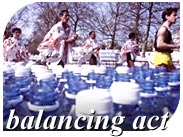We are constantly being bombarded
with advice, sometimes conflicting, on how much water to drink during
exercise. Which scientific advice are we to believe?
Dehydration as low as 2% will
cause your performance to decrease by 20%, claim some drink
manufacturers. On the other extreme, athletes in ultra-endurance events
have become seriously ill from drinking too much water during exercise,
even when following scientific advice on fluid replacement. “Drink
less” is the latest scientific advice.
Which scientific advice are we to believe? The problem is that the short
answer to most questions regarding exercise physiology is, “it
depends”. This is because the range of the individual variation in
everything from fluid requirements to training capacity has been either
underestimated by scientists, or poorly communicated to athletes. This
article shows how to combine scientific advice with your particular
characteristics and requirements.
In essence, your water intake during exercise depends on your sweat loss
and the rate at which your body can absorb water. Sweat rate is
determined by exercise intensity, temperature and humidity, effective
windspeed, although there is a wide individual variability.
The individual variability is very important – even at the same
exercise intensity, there can be large variations in sweat rate between
people of similar size and body composition, so you need to determine
your sweat rate for a given set of conditions and exercise intensity.
To do this, weigh yourself before and after an exercise bout, add the
difference in your weight to the volume of fluid you drank, and you have
your total sweat loss. Divide this value by the number of hours
exercised to get your hourly sweat rate.
Sweat rates vary between less than 500 ml per hour for moderate exercise
in cool environments, up to several litres per hour during severe
exercise in hot humid environments.
Once you know what your approximate sweat rate is for different
conditions, you need to apply a simple rule: drink as close to this
amount as is comfortable, up to a maximum of about 750 ml per hour, as
this is about the maximum rate at which the gut can absorb fluid. Of
course, there are exceptions to this rule: some cyclists can comfortably
drink up to 1 litre per hour for 3 hours at a time.
Then you need to apply some common sense to your drinking. If you are a
heavy sweater, it is inevitable that you will become dehydrated to some
extent during prolonged exercise, which will have an effect on your
performance.
However, before you start chugging huge volumes of water, consider the
effects of having an over-full stomach while racing, and modify your
fluid intake accordingly. In this way, you will achieve a better result,
even though you will be more dehydrated at the end of the event.
Do not wait until you are thirsty before drinking, as thirst is a
notoriously poor indicator of dehydration. Instead, drink about 350 ml
of water (or energy drink) 10 minutes before the start, and continue
drinking small quantities at regular intervals of 10 – 15 minutes.
This strategy is important, as it will result in the fastest emptying of
the stomach: the fuller the stomach, the faster it empties, resulting in
faster delivery of fluid to the blood.
While you might need to be close to a toilet or some bushes at the start
of the race, you need not worry that you will need to urinate during the
event, as the blood flow to the kidneys, and subsequent urine formation,
is much reduced during exercise.
However, the nature of racing means there is another practical issue.
The intensity of the race varies, which means that sometimes it is
impossible to drink as often as you should. This means that you will
have to “catch up” whenever there is an easing up of the pace. In
addition, the temperature often increases substantially during
early-morning funrides, which results in increased sweating and fluid
requirements later in the race.
What do you do when you can’t carry enough water for a race? Well, it
depends! If you can’t get someone to hand you a bottle en route, you
might choose to stop and refill your bottle from a water station, or
tough it out to the finish.
Do you finish your water well before the finish to stave off dehydration
as long as possible, or do you save a little for the psychological boost
of a drink when the action really hots up towards the end?
What about saving a bit with which to cool your head instead of drinking
it? It really depends on what works for you. You can often get greater
relief from the heat by pouring a bit of water over you head than
drinking it. Research is under way at the Sport Science department at
the University of Birmingham to determine the benefit of headcooling
during exercise, the results of which will be posted on this site as
soon as they are released.
What you do depends on your state, how close you are to the finish and
how important your position is to you. Still, be careful – many people
tough it out and get caught out by the combination of dehydration and
rapidly rising temperature as the race wears on, and finish shattered,
which is unpleasant, or really ill, which is dangerous.
Most importantly, it is important to practice your drinking strategy
well before important races, and under similar conditions to those on
race day, so that your drinking strategy becomes second nature.

